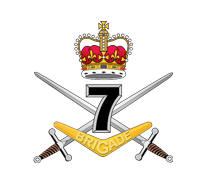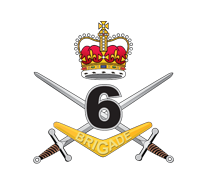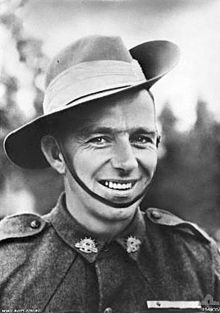
The Australian Army Reserve is a collective name given to the reserve units of the Australian Army. Since the Federation of Australia in 1901, the reserve military force has been known by many names, including the Citizens Forces, the Citizen Military Forces, the Militia and, unofficially, the Australian Military Forces. In 1980, however, the current name—Australian Army Reserve—was officially adopted, and it now consists of a number of components based around the level of commitment and training obligation that its members are required to meet.

The Royal Queensland Regiment (RQR) is a reserve light infantry regiment of the Australian Army based in Queensland. Part of the Royal Australian Infantry Corps, the regiment was established in 1960 following a reorganisation of Australia's part-time infantry regiments that saw the creation of six state-based regiments through the amalgamation of the previously existing regionally designated infantry battalions. Initially only two battalions were raised, but since then the size of the regiment has fluctuated depending upon the Army's requirements. There are currently three battalions within the regiment based at various locations throughout Queensland, all of which are assigned to the 11th Brigade.
The 25th Battalion was an infantry unit of the Australian Army. Raised in early 1915 as part of the Australian Imperial Force during the First World War, the battalion fought at Gallipoli and in the trenches along the Western Front, before being disbanded in early 1919. In mid-1921, it was re-formed as a part-time unit based in the state of Queensland. Throughout the 1930s, the battalion was merged briefly with the 49th Battalion as a result of manpower shortages, but was later re-raised in its own right. During the Second World War, the 25th deployed to New Guinea where they fought the Battle of Milne Bay in August and September 1942. Later in the war, the 25th took part in the Bougainville Campaign. During the post-war period, the 25th Battalion became part of the Royal Queensland Regiment, variously forming battalion or company-sized elements, before being merged with the 49th Battalion to form the 25th/49th Battalion, Royal Queensland Regiment.

7th Brigade is a combined arms formation or brigade of the Australian Army. The brigade was first raised in 1912 as a Militia formation, although it was re-formed as part of the First Australian Imperial Force in early 1915 for service during World War I. It subsequently saw action at Gallipoli and on the Western Front during the war. Following the end of the war the brigade was disbanded in 1919 before being re-raised in 1921 as part of the Citizens Force. During World War II the brigade took part in the fighting against the Japanese in New Guinea and on Bougainville. Today, the 7th Brigade is part of 1st (Australian) Division and is based in Brisbane, Queensland and is composed mainly of units of the Regular Army. While the brigade has not deployed as a whole unit since World War II, component units have deployed on operations to East Timor, the Solomon Islands, Iraq and Afghanistan.

The 9th Battalion, Royal Queensland Regiment is a Reserve light infantry battalion of the Australian Army, raised and based in the state of Queensland. It is part of the Royal Queensland Regiment and is currently attached to the 11th Brigade of the 2nd Division. 9 RQR can trace its history as far back as 1867 with the establishment Queensland Volunteer Rifle Corps, although it was not until 1911 that it was designated as the "9th Battalion". Over the course of its history, the battalion has served Australia in a number of conflicts including The Boer War, World War I and World War II, while more recently, members of the battalion have been involved in various peacekeeping operations and exercises around the Pacific region.

The 1st Battalion was an infantry battalion of the Australian Army. Although its numerical name was designated during the First World War, the 1st Battalion can trace its lineage back to 1854, when a unit of the Volunteer Rifles was raised in Sydney, New South Wales. This unit has since been redesignated a number of times, but through its links with the units of the colonial NSW defence force, the battalion's history includes services in Sudan and South Africa. During the First World War, the 1st Battalion was raised for overseas service in 1914 as part of the First Australian Imperial Force. Attached to the 1st Brigade, the battalion served in Egypt initially before taking part in the fighting in Gallipoli against the Turks. Later the battalion was sent to the Western Front where it fought in the trenches in France and Belgium as part of the Australian Corps. Following the end of the war the battalion was disbanded in 1919.

The 3rd Battalion was an infantry battalion of the Australian Army. Originally raised as part of the First Australian Imperial Force for service during World War I, the battalion formed part of the 1st Brigade, attached to the 1st Division. It was formed shortly after the war broke out and was among the first Australian units to be sent overseas, arriving in Egypt in December 1914. In April 1915 the battalion participated in the Landing at Anzac Cove, coming ashore in the second and third waves. In December 1915 the 3rd Battalion was evacuated from the Gallipoli peninsula and withdrawn to Egypt again, where it took part in the defence of the Suez Canal before being sent to France to fight on the Western Front in March 1916. For the next two and a half years the unit would serve in the trenches in France and Belgium and would take part in many of the major battles fought during that time. In May 1919, following the end of the war, the battalion was disbanded and its personnel repatriated back to Australia.

The 4th Battalion was an infantry battalion of the Australian Army. Originally raised as part of the First Australian Imperial Force during the First World War, the battalion formed part of the 1st Brigade, attached to the 1st Division. During the war the battalion fought at Gallipoli and in the trenches on the Western Front, before being disbanded in 1919. In 1921, the battalion was re-raised as a militia unit and designated as the "4th Battalion ", adopting the designation of the Australian Rifles militia unit from which many of the battalion's recruits had come during the war. In 1930, the battalion was amalgamated with the 3rd Battalion and they remained linked until 1936, when they were delinked.

The 6th Battalion was an infantry battalion of the Australian Army. Originally formed in 1914 for service during the First World War, the battalion fought at Gallipoli and on the Western Front. The battalion was disbanded in 1919 but was re-raised in 1921 as part of the Citizens Force, and adopted the title of "Royal Melbourne Regiment" in 1935. The battalion did not serve overseas during the Second World War and was eventually disbanded in 1944. It was re-raised in 1948 and remained in existence until 1960 when it was absorbed into the Royal Victoria Regiment. Today its honours and traditions are maintained by the 5th/6th Battalion, Royal Victoria Regiment.

The Victorian Scottish Regiment (VSR) was an infantry regiment of the Australian Army. Formed in 1898 as a volunteer unit of the colonial Victorian Military Forces, the unit went through a number of changes in name over the course of its 62-year history. During World War I many of its members volunteered for overseas service and saw action at Gallipoli and on the Western Front in France. Following the end of the war, the regiment was reorganised to perpetuate the honours of the 5th Battalion, AIF. During World War II the battalion was employed on garrison duties in Australia, although many of its members volunteered for overseas service and fought in campaigns in North Africa, the Middle East and New Guinea. Following the war, the battalion was re-raised as part of the Citizen Military Forces and undertook the training of national servicemen until 1960 when the unit was disbanded and absorbed into the 1st Battalion, Royal Victoria Regiment. Today, the regiment's traditions are maintained by 'B' Company, 5th/6th Battalion, Royal Victoria Regiment.

The 41st Battalion, Royal New South Wales Regiment,, is an infantry battalion of the Australian Army. An Army Reserve unit, it is one of four battalions of the Royal New South Wales Regiment and is attached to the 5th Brigade, 2nd Division. It is based in northern New South Wales, with its headquarters in Lismore and depots in a number of locations including Taree, Tweed Heads, FGC (Grafton), Kempsey, Port Macquarie and Coffs Harbour. In its present form the battalion was raised in 1965, however, it can trace its lineage back to a couple of Scottish Rifles units formed in the 1800s in Byron Bay and Maclean. It also perpetuates the battle honours and traditions of the 41st Bn AIF, that served on the Western Front during World War I.

The 11th Brigade is an Australian Army brigade which currently comprises most Australian Army Reserve units located in Queensland. The brigade was first formed in early 1912 following the introduction of the compulsory training scheme. Later, as part of the 3rd Division and saw action during World War I on the Western Front as part of the First Australian Imperial Force. In the interwar years, the brigade was re-raised with its headquarters in Brisbane.

The 11th/28th Battalion, Royal Western Australia Regiment is a Reserve infantry battalion of the Australian Army. Located in Western Australia, it is one of the two battalions of the Royal Western Australia Regiment which forms the infantry component of the 13th Brigade.

The 14th Light Horse Regiment was a mounted infantry or light horse unit of the Australian Army. The unit takes its lineage from units raised as part of the colonial forces of the state of Queensland in 1860 and served during the Second Boer War and World War I. In 1930 it was amalgamated with the 2nd Light Horse Regiment to become the 2nd/14th Light Horse Regiment, a unit that continues to exist as part of the Australian Army today.

The 31st Battalion, Royal Queensland Regiment was a Reserve infantry battalion of the Australian Army. Although it was officially formed as 31 RQR in 1965 the battalion can trace its lineage back to units formed in 1881 as part of the colonial defence forces of the state of Queensland.
The 49th Battalion was an infantry unit of the Australian Army. Raised as part of the Australian Imperial Force during the First World War, the battalion fought along the Western Front between mid-1916 and late 1918, before being disbanded in early 1919. In 1921, it was re-formed as a part-time unit based in the state of Queensland. Throughout the 1930s, the battalion was merged a couple of times as a result of manpower shortages, but in early 1940, as Australia mobilised for the Second World War, the 49th was expanded and the following year deployed to New Guinea to undertake garrison duty. Following Japan's entry into the war, the 49th was committed to the fighting in the early stages of the New Guinea campaign, taking part in the Battle of Sanananda in December 1942, where it took many casualties and suffered heavily from disease. The battalion was withdrawn back to Australia in early 1943 and subsequently disbanded in July, with the majority of its personnel being redistributed to other units. During the post-war period, the 49th Battalion was subsumed into the Royal Queensland Regiment, existing between 1966 and 1997, before being merged with the 25th Battalion to form the 25th/49th Battalion, Royal Queensland Regiment.

The 6th Combat Support Brigade is an Australian Army brigade. First formed in 1912 as a Militia formation to provide training under the compulsory training scheme, the brigade was re-raised during the First World War as an infantry unit of the all volunteer Australian Imperial Force. It subsequently served at Gallipoli and in France and Belgium on the Western Front. In the 1920s, as part of a reorganisation of the Australian Army, it became part of the 3rd Military District of the Citizens Military Force, encompassing units from Victoria and South Australia. In 1991, it became part of the Ready Reserve Scheme, based at Enoggera Barracks, in Brisbane, Queensland, before being disbanded in 1996 when the scheme was discontinued. The brigade was re-raised on 1 March 2010 to oversee the Army's command support and intelligence, surveillance, target acquisition and reconnaissance units.

The 47th Battalion was an infantry battalion of the Australian Army. It was originally raised in 1916 for service during the First World War. The battalion then took part in the fighting in the trenches of the Western Front in France and Belgium, before being disbanded in early 1918 to provide reinforcements for other Australian units that were suffering from a manpower shortage following the German spring offensive. In 1921, it was re-raised as a part-time unit of the Citizens Force, which later became the Militia. During this time it was based in south-east Queensland and in 1927 it became known as the "Wide Bay Regiment". During the Second World War the 47th Battalion took part in fighting in New Guinea and Bougainville, before being disbanded again in January 1946. Later, the battalion was re-raised before eventually being subsumed into the Royal Queensland Regiment in 1960.

The 30th Battalion was an infantry battalion of the Australian Army. It was originally formed in 1915 during the First World War as part of the all-volunteer Australian Imperial Force (AIF) and saw service on the Western Front before being disbanded in 1919. It was re-raised in 1921 but was later amalgamated with the 51st Battalion in 1930. In 1935 the two battalions were delinked and the 30th re-raised in its own right. During the Second World War it undertook garrison duties in Australia before undertaking active service in New Guinea in 1944–1945. After the war, it was disbanded in early 1946. In 1948, the battalion was re-raised again and remained on the order of battle until 1960 when it was absorbed into the Royal New South Wales Regiment.

The 42nd Battalion was an infantry battalion of the Australian Army. Raised as part of the Australian Imperial Force (AIF) during the First World War, it was established at Enoggera in December 1915, forming part of the 11th Brigade in the 3rd Division. It subsequently served on the Western Front in France and Belgium in 1916–18 before being disbanded on 22 October 1918. In 1921, the battalion was reformed as part of the Citizens Forces becoming known as the 42nd Battalion. Following the outbreak of the Second World War the battalion held a number of training exercises and camps until 1941, before being mobilised in March 1942 as part of the 29th Brigade, in the 5th Division. It subsequently served in New Guinea fighting against the Japanese during 1943–44 and on Bougainville in 1945, before being disbanded on 7 May 1946. In 1948, it was reformed as part of the re-raised Citizens Military Forces. Today, its lineage is perpetuated by the 31st/42nd Battalion, Royal Queensland Regiment, a unit which continues to serve in the Australian Army Reserve.



















